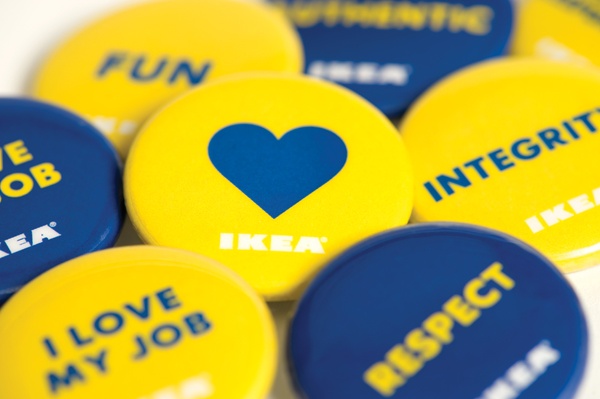The Alan Key to success: Why IKEA is better than the rest

IKEA are the biggest global furniture retailer, and with good reason. Their winning formula is simple, but thorough, and they're constantly innovating to stay ahead of the curve.
The blue-and-yellow IKEA branding has become more than just a logo. It’s the stamp of a certain way of life: the IKEA way of life. It heralds a place where value, durability, and simplicity are prided above all else, and building homes that promote ‘togetherness’ is the ultimate aim.
IKEA’s dominance of the furniture market is impressive. 1% of the entirety of the world’s timber felled becomes an IKEA product. Turnover is a stunning £300 billion. 1 million swedish meatballs are served up every year; a BILLY bookcase is produced every 4 seconds; and IKEA catalogues are printed more than either the Bible or the Quran. IKEA is the world’s biggest furniture provider, and their founder (who passed away in January) died the eighth richest person in the world.
A combination of constantly preserving their ethos, whilst continually updating their offerings, ensures they remain one of the most well-known and well-liked brands in the world.
Here are a few other things they’re getting right.
Innovate through partnerships
IKEA’s ideology of togetherness doesn’t just extend to its customers. Rather than trying to do everything themselves (and risking doing a less-than-perfect job), IKEA is always collaborating with industry experts to make sure their products are at the cutting edge of tech.
Their Home Smart initiative is a great example of this. The third (and final) stage is in the pipeline for 2019 and so far, all we know is that it’s going to be all about sound. It will be the result of an alliance between IKEA and Sonos.
Synonymous with delivering music anywhere in the home, Sonos is a widely-known and respected player in the music technology business. It grants IKEA instant credibility in home speaker systems, before they’ve even started.
What’s more, it promotes the integration that IKEA is so well-loved for. ‘Built-in’ is always an attractive proposal: who wants two separate products when one will seamlessly integrate both tasks? It challenges consumers to think of IKEA not as the makers of just beds, sofas, and tables, but as the provider of a full-package home. They’re not snobby either. They’ve worked hard to ensure their new smart furniture pairs with Amazon’s Alexa, Google Assistant, and Apple’s Homekit.
If the first two stages of their Home Smart initiative are anything to go by, the venture into speaker systems will be a roaring success. The almost sci-fi concept of smart homes is one that, for a long time, seemed inaccessible—voice-triggered blackout blinds and clap-activated speakers are foibles for the rich and famous, right? Not if IKEA has anything to do with it.
The first stage (implemented back in 2015) was the integration of Qi wireless charging with its furniture. 2016 saw stage two become a reality: a range of lighting products controlled by a remote (so that even those averse to smart homes could enjoy them) or an app. The key has been to keep things simple and centred around the consumer.
Björn Block, head of the Home Smart department, knows this is why people have taken to it so quickly: “The smart home has been possible for some time, but there’s been two major dilemmas. It’s too complicated, and too expensive. Let’s make it super easy to install and super easy to understand, at a price tag you haven’t seen before.”
This founding value of democratising big-ticket items extends to everything they do.
Their new FREKVENS collection (“frequency” in Swedish) has all you need to throw a killer house party. Again, they partnered with an industry expert (this time Teenage Engineering, for their party and sound engineering expertise) in order to make the home, and gathering in the home, cheaper and easier, without a loss of quality.
Their approach to AR (augmented reality) and VR (virtual reality) is equally inclusive. Their AR app, IKEA Place debuted last year. Download the app; hold your camera up to a space in your home; choose a piece of IKEA furniture and watch it drop into its virtual place. Simple. It was crucial to the company that there’s no need for special skills, or goggles. Anyone with an iPad or iPhone can use it.
Michael Valdsgaard, head of Digital Transformations, acknowledges that they could take things further and make use of VR but that ‘people are not super comfortable with it.’ For IKEA, consumer need has to be a driving factor: if it’s just going to clog up people’s lives, IKEA won’t make it.
Yellow and Blue = Green
Although, in many aspects, IKEA likes to let its consumers take the lead on determining what they make, they make sure to lead change where it really counts. Currently, they’re spearheading a variety of environmental initiatives to make it easier for the average homemakers to go green.
Through yet another partnership—this time with Big Clean Switch—IKEA is offering to switch people to cleaner, cheaper energy. It’s been predicted to save all participating households £300 in gas and electricity bills. More to the point, it promises 100% renewable energy. For each sale IKEA makes, the commission payment they receive goes straight to supporting local community initiatives. It ensures consumers continue to think of IKEA electrics as forward-thinking; and promotes them in our minds as a brand constantly looking to save us money.
It’s not their first foray into environmental tech. Last year IKEA UK started selling home solar panels and battery storage. All of its new stores, and most of its existing stores, are now being equipped with solar panels. And their Copenhagen-based innovation lab, Space10, is looking to take on Elon Musk in the fight to bring environmental solutions to everyday consumers.
But they’re not fussed about being seen as futuristic. The research being carried out is, in many ways, more modest than at Tesla. Their Growroom (a round wooden orb that allows for ambitious urban gardening) is simple by design, but hopes to bring grow-your-own-produce to the masses.
Combined with Sprout—groundbreaking technology that will allow you to interact with plants to find out whether their pH balance, nutrition, and light need adjusting—Space10 are hoping they might be able to transform farming, and food education.
But all this technology is nothing if it’s not useful. In their own words, Space10 must always be “a future-living lab where we explore better, more meaningful and more sustainable ways of living — based on the needs of people.” They see themselves as an “outside-in lab” with fingers in various pies, from open-source architecture, to hydroponic food systems, to machine learning. It’s explorative and playful, but it’s always bringing things back to the everyday of an average consumer.
Stick to what people love
And though all these inventive initiatives are going on, they happen in the background. On the face of it, for most consumers, IKEA is still doing what it’s always done: providing flat-pack furniture that lasts, at affordable prices. Their winning formula—not too much choice; easy to assemble and easy to use; stores that are part shop, part day-trip experience—is as enticing as it ever was.
The popularity of the model is evident when you look at their expansion plan. The only markets that IKEA is not yet competing in are India and Latin America, and that’s set to change with 25 blue-and-yellow warehouses expected to pop up across India by 2025.
Behind the scenes, IKEA are constantly exploring new technology, but at the same time, the front-of-house show goes on, just as it always has.
Conclusion
IKEA are a great example of a brand that know what their consumers think of them. They continue to do the things that work (their best-seller, the Billy bookcase, was designed in 1978) and they look into upcoming consumer demands (smart homes being their latest initiatives).
They are absolutely brilliant at knowing what matters to consumers (ease of use and value for money) and they capitalise on this. As they look to expand into new markets, they make sure to get expert advice (either from partnerships, or from their regular home visits where they speak directly to the consumers who shop with them).
IKEA have worked out the key to success, and it’s nothing other than consumers. They put their customers at the heart of everything they do, and it’s reflected in their market dominance.
If you want to find out what it is about your brand that consumers love, or want to see which areas you should be innovating in, get in touch to find out how we can help.
Tell us what you think of this article by leaving a comment on LinkedIn.
Or share it on:
